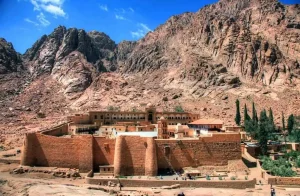Monasterio de Santa Catalina en el Sinaí
Saint Catherine Monastery in Sinai Peninsula is one of the main monuments in the region. Since the early centuries of Christianity in Egypt, South Sinai has played significant role in the activities of asceticism and monasticism. Thanks to the geographical and geological characteristics of the Sinai region. The southern Sinai was always a great attraction for Christian monks due to the hills and solemn, serene and secluded nature.
¿Quién fue Santa Catalina?
Santa Catalina was a beautiful young woman. She lived in Alejandría during roman empire persecution against Christians. At that time, emperor Maximinus (305-313 AD) was ruling the empire. Catherine converted to Christianity and refused to marry the pagan noble who asked for her hand. When the Romans discovered her conversion to Christianity, they tortured her horribly. However, she did not abandon her new faith. Finally, She beheaded in 307 AD and became a martyr of great holiness. Five centuries after her death, a monk in Siani had a vision, he saw angels carried her body. There also placed it on top of Mount Sinai. Consequently, the monks carried the relics of St.
Historia de la construcción del monasterio
In 342 AD, Empress Helena, mother of Emperor Constantine asked some monks to build a monastery which includes a chapel dedicated to the Virgin Mary at the foot of Mount Moses. In the sixth century the Byzantine Emperor Justinian built a church known as the Church of Transfiguration. But after the dictates of the illusion monk who said that the angels carried the corpse of Saint Catharine to top of the Sinai Mount, the Byzantine emperor Justinian gave the Monastery a group of 200 soldiers to defend the monastery against the attacks of the nomads. The Monastery is at the foot of Monte Moisés, a region characterized by beautiful and serene landscape, close to water courses.
La iglesia principal
It has the form of basilica style consisting of a central nave and two sides ending by small shrines. Thu nave ends with an altar; on the west of its side, a marble place dedicated to preserve the relics of Santa Catherine. The central apse of the church lines with a wonderful Byzantine mosaic. The monastery contains about 2000 unique icons which are the most important and ancient icons worldwide. Some icons date from the fifth century and others from the eighth century. Fantastic icons display on the hall wall above the main entrance of the Church.
Biblioteca del convento
The monastery has one of the biggest libraries of the Christian World. This library contains a large amount of old and rare manuscripts of approximately 3,500 volumes in Greek, Coptic, Armenian, Arabic, Hebrew, Slavic and other languages. Moreover, it has a lot of decrees of the caliphs, rulers and Muslim governors who related with the monastery. In fact, these documents were very important to many scholars around the world until the University of Alexandria in Egypt and the Library of Congress of the United States in Washington microfilmed it.
La Mezquita
La pequeña mezquita se construyó en 1106 dC (alrededor de 500 AC) durante el reinado del califa fatimí "Al Amer” for pilgrims who needed to rest and pray during the pilgrimage journey from Egypt and North Africa to Mecca. It is located southwest of St. Catherine’s Church. It has a rectangular shape of 11 m long, 7 m wide. The mosque walls were built of granite coated clay and plaster.
Los Pozos, Casa de los Cráneos y la Casa de Huéspedes
There are boreholes in different locations to provide the holy place with water. The most important is the Well of Moses located north of St. Catherine’s Church and well of St. Stephen and others to the south of the main church. Within the grounds is a small building that was built in 1863 during the reign of Governor Ismael Pasha de Egipto dedicado a la casa de los visitantes del monasterio.
In front of the Church of Saint Catherine there is a garden including a cemetery for the monks. Near it, there is a House of Skulls which was used for preserving the skulls of the deceased monks.






